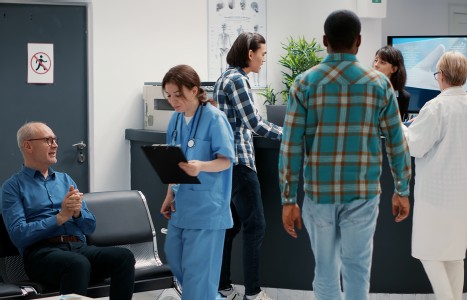When I graduated from chiropractic college in 1981 and started practice, I heard it all, and very little was positive. “You are a quack; you do not know what a subluxation is; you couldn’t get into a real health care program, so you chose the one that is slightly above a mail-order degree; you have no proof that chiropractic works; Are you really licensed?”, and so much more.
| Digital ExclusiveKnee Rehabilitation, Part III
Over the last two months, we have discussed electromyographic (EMG) findings with regards to standard knee exercises. This month, we will discuss some interesting findings with regards to approaches commonly used with knee rehabilitation, including treadmill and stair-stepping exercises. We will attempt to answer the following questions:
- Is there preferential recruitment of muscles using either treadmill, stairstepping, or bicycle exercise for knee rehabilitation?
- What modifications to the exercise prescription should be employed if the patient has patellofemoral problems or anterior cruciate ligament (ACL) deficiency/damage?
Graded Treadmill Walking
Treadmill walking is often prescribed during the early phases of rehabilitation after significant injury or surgery. One study1 measured the EMG activity of leg muscles at 0 percent to 24 percent grade (incline). As the grade increased, there were significant increases in vastus medialis oblique, vastus lateralis and biceps femoris activity. The increases in the vasti muscles were about double that of the biceps femoris.
Interestingly, there was no such increase in the peak amplitude of the medial hamstrings. Although there were increases for the quads and biceps femoris, it is not know whether this amount of increase contributes to a strengthening affect. The average amplitude was less than 25 percent of a maximum voluntary contraction for all the muscles regardless of grade.
As the grade was increased, the ankle and hip range of motion increased while the knee range of motion decreased. The decrease in knee range of motion was due to a specific decrease in knee extension with an increase in grade. So although the knee flexion angles remained similar through different grades, the amount of extension achieved decreased with increasing grade.
The authors suggest that a balance between the needs of an anterior cruciate deficient patient and patient with patellofemoral pain may be met by having the patient use a grade of just greater than 12%. They suggest that at this grade, the knee remains bent around 30 degrees and therefore avoids extension which is detrimental to the ACL patient. This amount of grade also avoids the middle to extreme flexion positions that may be detrimental to the patellofemoral pain patient.
Stairstepping
Stairsteppers have become quite popular as an aerobic alternative to treadmills. Little research has been performed for stairsteppers; therefore, most of the claims are anecdotal or promotional. One study2 evaluated the EMG activity of muscles about the knee and hip. The researchers monitored the activity of these muscles with increasing cadence and also measured again with retrograde stepping. Their results indicated increases in muscle activation for the gluteus maximus, rectus femoris, vastus medialis and gastrocnemius with increases in stepping cadence. There was generally no significant increases for the semimembranosus and semitendinosus, except for the extremes of 35 to 95 steps per minute. However, with retrograde stepping at a cadence of 60 steps/minute, there was an increase in the medial hamstring activity. Interestingly, there was no increase in gluteus maximus activity as predicted by many stairstepper enthusiasts and manufacturers.
Placed in the context of rehabilitation for an ACL-deficient knee, it was observed by the authors that the increase in hamstring activity was minimal, whereas the quadriceps increase was greater with stair stepping. To achieve a balance so that there is less strain on the ACL and more stability from the hamstrings, it was recommended that stepping at a slower cadence was probably safest. There was no particular advantage to faster stepping given the lack of hamstring activity increases. They also felt that although there was an increase in medial hamstring activity with retrograde stepping, it was rather minimal. The awkwardness of the activity did not justify using this method as an alternative to forward stepping. It should be noted that retrograde stepping is more aerobically demanding.
Bicycle Riding
It is generally accepted that bicycle riding is a good approach to ACL injury whether surgically managed or not. The concerns, as always with ACL deficiency, are extension of the knee and quadriceps contraction pulling the tibia forward on the femur. A recent study measured the strain behavior for the ACL with bicycle riding using different power levels and cadences (60 and 90 rpm) and found no significant differences among them. This suggests that there is enough muscular control to compensate for increases in either resistance or cadence.
In fact, the quadriceps were most active when the knee was in flexion, which would act as a stabilizer through a posteriorly directed pull. Although this may seem contradictory to visual judgement, due to an angle of pull change at around 60 to 70 degrees of knee flexion, the quadriceps produce a posteriorly directed force. ACL strain was greatest between about 120 to 200 degrees (0 degrees with pedal at top; 180 degrees with pedal at bottom). This correlates with a high EMG activity of the gastrocnemius.
It is always difficult to summarize large amounts of information in a short column. Table I is a summary of recommendations for exercise and avoidances for specific knee problems. I hope this is a useful addition to your working knowledge of knee rehabilitation.
Table I: Exercise program for specific conditions.
| Specific Emphasis or Modifications to the General Program | ||
| Condition | Emphasize | Avoidance/Contraindication |
| ITB Syndrome |
|
|
| Patellofemoral Arthralgia and Chondromalacia |
|
|
| Meniscus Tears |
|
|
| ACL Tears |
|
|
| PCL Tears |
|
|
| MCL Tears |
|
|
| Patellar Tendinitis |
|
|
| Osgood-Schlatter's |
|
|
References
- Lange GW, Hintermeister R, Schlegel T, et al. Electromyographic and kinematic analysis of graded treadmill walking and the implications for knee rehabilitation. JOSPT 1996;25:294-301.
- Zimmerman CL, Cook TM, Bravand MS, et al. Effects of stair-stepping exercise direction and cadence on EMG activity of selected lower extremity muscle groups. JOSPT 1994;19:173-180.


